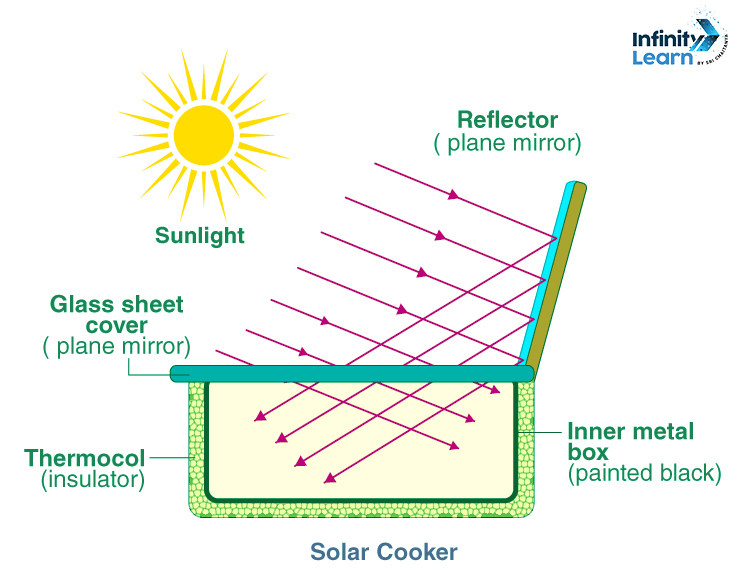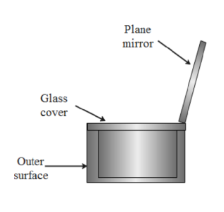Table of Contents
A Solar Cooker is a device that captures sunlight to cook food. Cooking food using a solar cooker can save you effort, time, and energy. Solar energy is easily available, and it is possible to capture this energy using a solar cooker device. Solar energy can be used in several other ways. Because solar energy is renewable, possibilities exist that it can be used further in the future.

What is a Solar Cooker?
A solar cooker is a device that uses solar energy to fry, bake, boil, and grill foods instead of gas or electricity. Solar cooking is the process of harnessing solar energy for cooking purposes.
For Solar cooking, a solar oven is used. This oven helps to use solar energy for cooking, heating, or sterilising foods and drinks. To heat foods, the solar oven uses direct sunlight. Cooking food using solar energy is also safe for children.
Components of Solar Cooker
A solar cooker has three main components
Box
A solar box cooker contains a box that works like an oven. Wood or metal materials are used to make this box, which has four walls. This box is also insulated so that no heat can escape from it. The inside of this box is painted black so that it can absorb as much heat as it can. This box can have more walls if required, depending on the size.
Reflecting Mirror
There is a reflecting mirror at an angle on the box’s edge. This mirror reflects all the sunlight to the box and also converges the sunlight towards the box. This helps the box to achieve its maximum heating capacity. The insulation is used to retain as much heat as possible.
Glass Sheet
On top of the opening of the box a glass sheet is placed. Hence, it does not stop any heat on its surface instead, pass through itself to the food or item that is kept in the box. This also acts as a cover of the box and protects the item kept in it from getting spoiled by pollutants or dust.
Solar Cooker Diagram
To understand the components of a solar cooker, follow the solar cooker diagram below.

Solar Cooker: Working Principle
The working principle of solar cooker works through three phases: concentrating the solar energy, converting the solar energy to heat energy and trapping heat energy.
- Concentrating the solar energy: Solar energy gives power to solar cookers. The reflectors outside the box direct and collect sunlight.
- Converting the solar energy to heat energy: The concentrated sunlight is focused onto a receiver, which is a cooking pan. The sun’s electromagnetic waves have the power to convert molecules inside matter. This converts the solar energy to heat energy, and hence, heat is produced through a process called conduction.
- Trapping heat energy: In this final phase, solar cookers capture and harness the heat to cook. Thus, the box gets hot inside. Hence, the food inside the box gets cooked. The temperature of a solar box cooker may rise upto 300 degrees Fahrenheit.
Panel cookers are lighter and smaller than box cookers. This feature makes them ideal for solar cooking while travelling. These cookers contain a small box oven in which the cooking vessel is placed. This cooking vessel is enclosed in a plastic bag that traps the heat.
Types of Solar Cooker
Box Type
Solar Box cookers, also known as box ovens, can cook the same food as a normal oven or slow cooker. As the name suggests, they have an internal chamber “box”. It is not necessary that it be square in shape. Commercially produced box ovens may reach 400o on a bright sunny day. Box ovens can be easily made from cheap or recycle materials and are ideal for cooking and classroom construction. These features help to heat up the box and thereby cook the food in the solar cooker.
Parabolic Type
The highest temperatures can be reached by using parabolic cookers. It can be used to fry or grill food without the need for pot covers or cooking bags.
Reflectors are used in parabolic cookers helps to focus a sufficient quantity of sunlight onto a single point of focus, hence letting the temperature reach to 500o. Parabolic-shaped cookers is easy to create using discarded satellite dishes or huge umbrellas.
While cooking, some safety precautions need to be kept in mind. Curved surfaces of a parabolic cookers direct more sunlight on a small area. The temperature of a parabolic cooker can reach up to 400 degrees Fahrenheit, which is ideal for frying food or baking bread.
Solar Cooker: Advantages
The advantages of a solar cooker are
- They are pollution-free hence save environment
- They are fuel-free which saves cost
- Solar power is a free resource
- It has low cost of management
- Reduces carbon impact by cooking without carbon dioxide-based fuels
Solar Cooker: Disadvantages
- Solar cookers become less effective when the sky is cloudy.
- Certain solar cookers require more time to prepare meals compared to a regular stove or oven.
- Windy conditions can hamper the cooking process for some solar cookers.
- Cooking thick foods like big roasts and loaves of bread might pose challenges
Solar Cooker: Uses in Daily Life
Just a little preparation solar cooker can be used to cook food. The best days for solar cooking are days when the sun is bright. Also, there are few or no clouds. In case of a few thin clouds, cooking will need extra time. Tracking the diretion of sun is important hence need to tracks yard.
For maximum efficiency, the cooker need to be placed in a spot where it faces directly into the sun. It is important to keep adjusting the solar cooker every one to two hours to keep it in direct sunlight.
Solar cooking is a very handy way to cook food in camping or traveling. As a panel cooker is smaller and lighter than other cookers, it can be used easily while traveling. On a sunny day cooking a meal can take two to four hours. One simple cooking process uses one-quart glass jars.
FAQs on Solar Cooker
What are Solar Cookers and their importance?
A solar cooker is a device that uses the sun's energy. It is mainly used for cooking purposes. It is also used for various purposes too. It converts solar energy to heat energy.
Which type of solar cooker is the best?
It depends on the type of solar cooker used. Usually solar box ovens reach temperatures around 300°F. Parabolic solar ovens, on the other hand, are more efficient and can reach a temperature of about 500°F
What are the disadvantages of a Solar cooker?
Solar energy can be used at a specific period of the day, . It is not possible to use at night, or during inclement weather, or in the winter when it is foggy. Compared to conventional cookers, it takes longer.
What is the most effective solar cooker?
The Haines 2.0 SunUp Solar Cooker and Dutch Oven Kit is a highly praised solar oven kit that can handle all your cooking needs. It can reach temperatures of up to 375 degrees Fahrenheit, thanks to its adjustable panels that help capture the most sunlight and transfer heat effectively.
Are solar cookers safe?
Solar cookers can cook various foods like meat, grains, legumes, vegetables, and fruits safely and conveniently if used correctly. Just like any other way of cooking, it's important to be cautious when using solar cookers to keep your food safe, especially when cooking meats, legumes, and grains.









